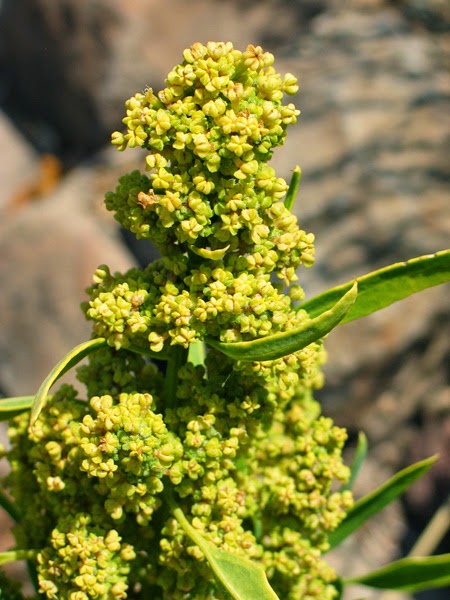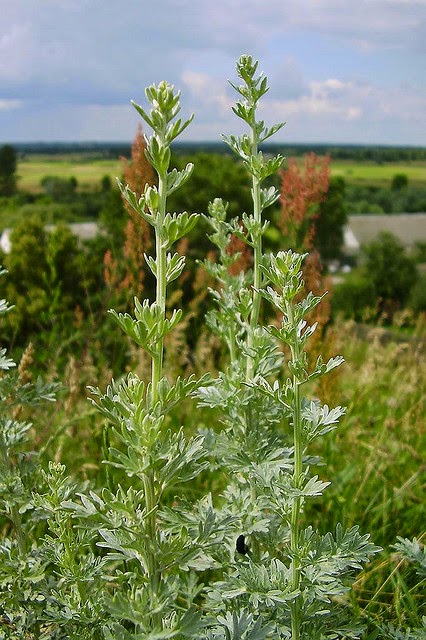 |
| Witch hazel |
Witch hazel (Hamamelis virginiana) is a deciduous tree or shrub that is native to Atlantic North America, and it is now also cultivated in Europe and Asia. The shrub can reach a height of 15 ft (4.6 m).
It flowers in the fall, producing vivid yellow flowers. Witch hazel is also known as hazel nut, snapping hazel, spotted alder, tobacco wood, winterbloom, and hamamelis water.
Native Americans used witch hazel leaves and bark as a poultice to reduce swelling and inflammation. Those are among the uses of this herb that has long been among the best known and widely used home remedies.
The word “witch” in the name of the herb is actually a derivative from the Anglo-Saxon word wych meaning flexible. The word described the flexibility of the branches that Native Americans used to make bows.
General use Witch hazel is a very versatile remedy, with generally accepted uses ranging from facial care to soothing aching feet. It is also used for the treatment of hemorrhoids, inflammation of the mouth and throat, and other conditions, such as varicose veins, wounds, and burns.
Witch hazel has so many applications that
Andrew Weil, M.D.
, called the decoction or tincture of the bark the “all–around astringent.” Weil, who practices natural and preventive medicine, recommended using witch hazel to ease the pain of sunburn, windburn, insect bites,
poison ivy
blisters, and sore and sprained muscles.
The medicinal element of witch hazel is the hamamelis water that is distilled, decocted, or tinctured from fresh and dried leaves, and fresh and dried bark and twigs. Tannins and volatile oils are the primary active ingredients of witch hazel that contribute to its astringent benefits.
The tannin content of witch hazel leaves is 8%, and in witch hazel bark ranges from 1–3%, as the medicine derived from the bark will yield a higher tannin concentration than that from leaves. Recent research done in Asia indicates that it is the tannin content of witch hazel that is chiefly responsible for its strong antioxidant activity.
As with other herbal astringents, witch hazel reduces the irritation on the tissue surface through a form of numbing. Surface inflammation is reduced, and the astringent creates a partial barrier against infection. That barrier aids in the treatment of wounds and burns. The astringency helps to
stop bleeding
, so witch hazel is useful in treating bruises, cuts, and other skin abrasions.
In addition, a cold compress of witch hazel is said to ease a headache. Cosmetically, witch hazel is used as a facial skin freshener and astringent to reduce pore size,
make-up remover
, and to reduce bags under eyes. Products for men that contain witch hazel include herbal shaving cream and aftershave.
The above are among the mainstream applications of the herb that
Native Americans regarded as a general tonic. They also brewed witch hazel as a tea for conditions including cuts, colds, heavy menstruation, tumors, and eye inflammation. Witch hazel was taken internally to stop bleeding from hemorrhage.
Some of those applications remain part of folk medicine. Other folk remedy applications of witch hazel include applications for backache, and internal use for diarrhea, nervousness, nosebleed,
vaginitis, and venereal disease.
As of 2002, there has been relatively limited research on the uses of witch hazel in the United States. There is agreement among alternative health practitioners that external use of this herb is safe.
Research conducted in Europe provides more information about applications of witch hazel. There, witch hazel products were approved for skin injuries, inflammation of skin and mucous membranes, and varicose veins.
Witch hazel and leaves were approved for the topical treatment of skin injuries, burns, varicose veins, and hemorrhoids. Recent studies carried out in Germany and the United Kingdom have established that witch hazel extract offers some protection against UV radiation prior to sun exposure as well as relieving the inflammation of sunburn.
In the United States, there is another controversy about the remedial benefit of witch hazel. Hamamelis water, when distilled, contains no tannin. Distilled witch hazel consists of a mixture of 14% alcohol in water with a trace of volatile oil. The astringent effect of witch hazel is due to an alcohol content similar to that of red wine. But the unstudied volatile oils exert some effects similar to topical tannin, and are also antimicrobial.
Preparations Witch hazel is available in various forms. Commercial preparations include witch hazel water and gels, although much commercial witch hazel is not true distilled witch hazel water. Witch hazel is also an ingredient in products, such as face and body pads and hemorrhoid pads, including Preparation H ointment.
As a topical astringent, witch hazel water is applied directly to burns, bruises, insect bites, and aching muscles. It can also be used to clean oily skin, remove makeup, or mixed with water for a relaxing footbath. Uses for the gel include treating cuts, diaper rash, and bedsores.
An infusion of fresh or dried leaves has been “cautiously used” in the treatment of internal hemorrhaging or to reduce excessive menstrual flow.
Infusion is a process that preserves the astringent tannin in witch hazel, using the leaves. A decoction may be prepared by simmering, not boiling, the herb’s bark.
This is done by steeping 1 teaspoon of witch hazel powder or twigs in a cup of boiling water. The mixture is boiled and covered for 10 minutes, then strained. After it cools, it can be applied directly or mixed into an ointment base such as
petroleum jelly
.
Uses of witch hazel leaf include remedies for diarrhea and menstrual conditions. The bark is used for skin injuries, inflammation of the skin, locally inflamed swelling, hemorrhoids, and varicose veins.
Witch hazel dosages Recommended dosages when using witch hazel are as follows:
- Witch hazel water (distillate) can be used as is or diluted at a 1:3 ratio with water.
- A poultice can be made by using 20–30% of witch hazel in semi-solid preparations.
- For an extract preparation, use a semi-solid and liquid preparation that corresponds to 5–10% of the drug.
- Decoctions of 5–10 grams of witch hazel extract per cup of water can be used for compresses and rinses.
- Ointment or gel is prepared by mixing 5 grams of witch hazel extract in 100 grams of an ointment base.
- The recommended dosage of suppositories is 0.1–1 gram of the drug. Suppositories in the rectum or vagina can be used from one to three times daily.
Applications Witch hazel is a multi-faceted remedy that is administered in several ways. Applications of witch hazel include:
- Gargle with a decoction of 1 teaspoon of witch hazel bark that has been steeped 10 minutes in boiling water and then strained.
- For skin conditions, ointment or cream can be used twice a day or as needed.
- Tincture can be placed directly on affected areas.
- A poultice can be applied to wounds and sores.
- Witch hazel extracts can be applied in combination with warm, moist compresses in the morning or at bedtime.
- For bruises, a washcloth can be used for a witch hazel compress. An ice cube placed inside the cloth keeps the compress cold and diminishes swelling.
HEMORRHOID RELIEF. Witch hazel’s applications include various methods for treating hemorrhoids:
- A hamamelis suppository can be inserted at bedtime to reduce inflammation of a swollen vein.
- For relief of hemorrhoids,Weil recommends moistening toilet paper with witch hazel. This compress is used to clean the anal area after bowel movements.
Combinations Hemorrhoid treatment accounts for two remedies that combine witch hazel with another herb, such as pilewort. Pilewort is also known as celandine. Another hemorrhoid remedy combines witch hazel with horse chestnut.
Furthermore, witch hazel is combined with aloe vera in commercial products such as skin care treatments. Home recipes for facial cleanser and mask include witch hazel, essential oils, and other ingredients.
Precautions  |
| Blooming witch hazel |
When witch hazel is administered in designated therapeutic dosages, no health risks have been recorded. However, when witch hazel is taken internally, its tannin content can lead to digestive complaints. Furthermore, in rare cases, liver damage is conceivable following long term administration.
Witch hazel water is intended for external use and most sources cite recommended dosages are for adults. The amount should be adjusted for older people and the chronically ill. Individuals should check with their doctors about use of witch hazel.
External use of witch hazel may result in minor
skin irritation
for some people. When this occurs, the amount of witch hazel should be diluted.
While it is safe to use witch hazel for gargling, caution should be taken when using it internally. Witch hazel contains small amounts of safrole, a compound that the U. S. Food and Drug Administration (FDA) banned for use in food during the 1960s.
That ban came after laboratory animals that ingested large amounts of the compound developed cancer. Witch hazel has not yet come under fire for safrole content. However, as of March 2000, there was little research information available. Additional study was needed on the safe use of this home remedy that was a staple for Native Americans.
Side effects Opinion varies about the side effects caused when witch hazel is taken internally. The tannin content can cause stomach irritation or cramping. A dose of 1 gram of witch hazel will cause nausea, vomiting, or constipation.
The FDA has approved witch hazel distillate as safe for external use. Sources had reported no known side effects as of March of 2000. However, future studies may provide more information about the safety or side effects of witch hazel.
Interactions The 1998 Commission E monograph reported no contraindications or interactions related to the use of witch hazel. However, there are well-known interactions between many drugs and high tannin herbs that are too numerous to list.
Those on blood thinners for circulatory trouble should take internal witch hazel preparations with caution if at all. In addition, witch hazel should not be taken internally with medications containing alkaloids, as it interferes with their absorption. Alkaloid drugs include atropine and codeine.





























